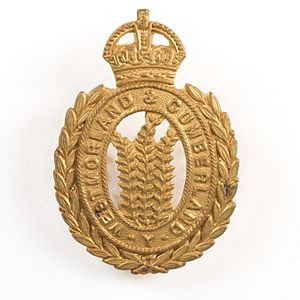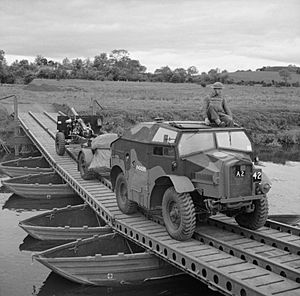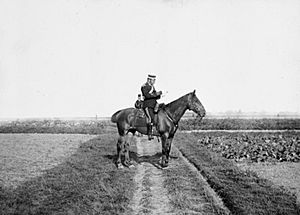Westmorland and Cumberland Yeomanry facts for kids
Quick facts for kids Westmorland and Cumberland Yeomanry |
|
|---|---|

Cap badge of the Westmorland & Cumberland Yeomanry
|
|
| Active | 16 October 1798–1 April 1971 |
| Country | |
| Branch | |
| Type | Yeomanry |
| Role | Cavalry Field Artillery |
| Size | 1–3 Regiments |
| Garrison/HQ | Penrith Artillery Drill Hall, Carlisle (from 1920) |
| Nickname(s) | Cumberland Hussars |
| Engagements |
|
| Battle honours | See battle honours below |
The Westmorland and Cumberland Yeomanry was a special cavalry unit in the British Army. It started way back in 1798. This unit sent soldiers to fight in the Second Boer War and served on the Western Front during the First World War. Later, they became infantry soldiers.
In 1920, the regiment changed to an artillery unit, using big guns. They served this way in the early parts of the Second World War. After that, they became part of the famous Chindits in Burma. After the war, they continued as a gunner regiment until 1971, when the unit's name disappeared.
Contents
- How the Yeomanry Began: French Wars
- The 19th Century: Keeping the Peace
- Imperial Yeomanry: Fighting in South Africa
- Territorial Force: Preparing for War
- First World War: From Horseback to Foot Soldiers
- Between the World Wars: Becoming Artillery
- Second World War: Global Service
- After the War: Changes and Disbandment
- Uniforms and Traditions
- Memorials
- See also
How the Yeomanry Began: French Wars
When Britain was fighting in the French Revolutionary Wars, the Prime Minister, William Pitt the Younger, had an idea in 1794. He suggested that counties should create groups of volunteer cavalry soldiers. These groups, called Yeomanry, could help defend the country if it was invaded. They could also help the local leader, the Lord Lieutenant, keep peace if there was trouble.
By 1798, the threat of invasion felt very real. The government encouraged local armed groups to form. That's when the first independent Yeomanry units appeared in Cumberland:
- Eskdale Five Kirks Yeomanry Cavalry, started on 16 October 1798.
- Cumberland Yeomanry Cavalry, started on 25 October 1798.
- Penrith Yeomanry Cavalry, started on 15 October 1801.
All these volunteer cavalry groups were disbanded after a peace treaty in 1802. But the peace didn't last long. When war started again, a new cavalry unit, the Cumberland Rangers, was formed around May 1803. The Eskdale Five Kirks and Cumberland Cavalry groups also reformed in 1806.
The 19th Century: Keeping the Peace
After the Battle of Waterloo in 1815, the Yeomanry's main job was to stop civil unrest. In 1819, six independent groups of Westmorland Yeomanry Cavalry were created. A Colonel named Henry Lowther paid for these himself. They were formed across both Westmorland and Cumberland:
- Westmorland units were in Kendal, Shap, and Appleby.
- Cumberland units were in Edenhall, Dalemain, and Milnthorpe.
By 1826, only two Westmorland Yeomanry groups remained. In 1828, the government stopped funding the Yeomanry. However, many units, including those in Westmorland and Cumberland, kept going without pay. They combined to form a single force: the Westmorland and Cumberland Yeomanry (WCY).
Funding for duty was brought back in 1831 because of more civil unrest. The WCY was called upon to stop Chartist riots in Penrith and Carlisle in 1839. In 1846, they helped stop fights between workers building the Lancaster and Carlisle Railway near Lowther Park.
The WCY units usually trained every year in Penrith. From 1843, the WCY units were formally organized into a regiment.
Imperial Yeomanry: Fighting in South Africa
After some tough defeats in December 1899, the British government realized it needed more soldiers for the Second Boer War in South Africa. They decided to let volunteer forces join. On 24 December, the Imperial Yeomanry (IY) was officially created.
This new force was made up of county companies, each with about 115 men. Volunteers from existing Yeomanry units and civilians quickly joined. These soldiers were trained to fight on horseback but also to dismount and fight like infantry. They used rifles and bayonets instead of cavalry swords.
The Westmorland & Cumberland Yeomanry formed the 24th (Westmorland & Cumberland) Company. This company arrived in South Africa on 5 March 1900. They served in the 8th Battalion, IY.
The Battle of Faber's Put
In May 1900, the 23rd and 24th Companies of the 8th Battalion were with a column led by Sir Charles Warren. On 26 May, they camped at a farm called Faber's Put. Warren hadn't placed enough guards, and before dawn on 30 May, Boer fighters surrounded the camp.
A Yeomanry guard spotted them and fired, starting a fierce battle. The Boers stampeded the Yeomanry's horses and shot down gun crews. The two Yeomanry companies moved forward to support their guards. They used their machine guns. The Yeomanry then advanced across open ground, using their bayonets. The Boers retreated. After this battle, Warren was able to clear the area without more trouble.
The 24th Company finished their service in May 1901 and returned home. They earned the regiment its first special award, known as a Battle honour: South Africa 1900–01.
After the war, all Yeomanry regiments, including the WCY, were changed into Imperial Yeomanry. They had a headquarters and four squadrons, each with a machine gun.
Territorial Force: Preparing for War
In 1908, the Imperial Yeomanry became part of a new force called the Territorial Force (TF). The WCY joined this new force, dropping 'Imperial' from its name. Its headquarters was in Penrith.
The regiment's squadrons were spread out:
- A Squadron was in Kendal, with smaller groups in other towns.
- B Squadron was in Penrith, with groups in Keswick and other towns.
- C Squadron was in Whitehaven, with groups in Workington and Maryport.
- D Squadron was in Carlisle, with groups in Wigton and Alston.
The WCY trained with other Yeomanry regiments.
First World War: From Horseback to Foot Soldiers
Mobilization for War
When war broke out on 4 August 1914, the TF units gathered at their training stations. The WCY was led by Lt-Col S.R. Fothergill.
The TF was originally for home defense. But when war started, units were asked to volunteer to serve overseas. Most soldiers agreed. Units were then split into:
- 1st Line: For overseas service.
- 2nd Line: For home service (for those who couldn't or wouldn't go overseas).
- 3rd Line: A reserve unit to train new soldiers.
1/1st Westmorland and Cumberland Yeomanry
The 1/1st WCY mobilized in August 1914. In spring 1915, the regiment was split up. Its squadrons were sent to different infantry divisions in the United Kingdom. These divisions were part of 'Kitchener's Army', a large volunteer army. The squadrons went to France that summer.
In June 1917, due to a shortage of soldiers, the regiment was told to give up their horses and retrain as infantry. On 22 September, many officers and soldiers joined the 7th (Service) Battalion, Border Regiment. This battalion was then renamed the 7th (Westmorland and Cumberland Yeomanry) Battalion.
2/1st Westmorland and Cumberland Yeomanry
The 2nd line regiment formed in September 1914. By July 1915, it was part of the 2/1st Western Mounted Brigade. In March 1916, this brigade was at Cupar, Fife.
In July 1916, many 2nd Line Yeomanry units were reorganized. Most were changed into cyclist units. The WCY was dismounted and its brigade became the 14th Cyclist Brigade. Later, it was renamed the 10th Cyclist Brigade. By January 1918, the brigade moved to Lincolnshire. Around May 1918, it moved to Ireland, where it stayed until the end of the war.
3/1st Westmorland and Cumberland Yeomanry
The 3rd Line regiment formed in 1915. It was linked to a Reserve Cavalry Regiment in Ireland. In 1917, it was absorbed by the 2nd Reserve Cavalry Regiment. By 1918, when the 1st Line regiment became infantry, the 3rd Line joined the 5th (Reserve) Battalion, Durham Light Infantry.
Between the World Wars: Becoming Artillery
After World War I, the War Office decided that only a few mounted Yeomanry regiments were needed. Most others would become artillery units. The WCY, being 17th in line, became part of the Royal Field Artillery (RFA) in 1920. It was called the 2nd (Cumberland Yeomanry) Army Brigade.
When the TF was reorganized into the Territorial Army in 1921, the unit was numbered as: 93rd (Westmorland & Cumberland) Army Brigade, RFA
- 369 (Westmorland Yeomanry) Battery
- 370 (Cumberland Yeomanry) Battery
Further changes happened, and by 1924, the RFA became part of the Royal Artillery (RA). The unit was then called: 51st (Westmorland & Cumberland) Field Brigade, RA
- Headquarters in Carlisle.
- 369 (Westmorland Yeomanry) Field Bty in Carlisle.
- 370 (Cumberland Yeomanry) Field Bty in Carlisle.
- 203 (Cumberland) Field Bty in Whitehaven.
- 204 (Cumberland) Field Bty (Howitzers) in Workington.
In 1938, the RA changed its names, and a 'brigade' became a 'regiment'. The TA was also doubled in size after the Munich Crisis. This led to the formation of two regiments from the original unit:
51st (Westmorland & Cumberland) Field Regiment, RA
- Headquarters in Carlisle.
- 370 (Cumberland Yeomanry) Field Bty in Carlisle.
- 203 (Cumberland) Field Bty in Whitehaven.
109th Field Regiment, RA
- Headquarters in Workington.
- 369 (Westmorland Yeomanry) Field Bty in Carlisle.
- 204 (Cumberland) Field Bty in Workington.
Second World War: Global Service
51st (Westmorland and Cumberland) Field Regiment, RA
The 51st (Westmorland & Cumberland) Field Regiment started the war as part of the 42nd (East Lancashire) Division. In April 1940, one of its batteries went to fight in the short Norwegian Campaign. The reunited regiment then sailed to Egypt later that year.
They fought in the Western Desert Campaign, helping to capture Bardia and then defending Tobruk. After being pulled out of Tobruk, they fought in the tough battles of Operation Crusader with the 7th Armoured Division, also known as the Desert Rats.
In February 1942, the regiment moved to defend Ceylon (now Sri Lanka) after Japanese attacks. In February 1943, they moved to India. In September 1943, they were changed into infantry soldiers trained for Long Range Penetration, joining the famous 'Chindits'. They formed 51 Column and took part in the Second Chindit Expedition. After this, some men went home, and others joined the Essex Regiment.
109th (Westmorland and Cumberland) Field Regiment, RA
Compared to the 51st, the 109th Field Regiment had a quieter war. It stayed in the UK for home defense. It was part of the 66th Infantry Division and later the 55th (West Lancashire) Division.

In May 1941, the 109th Field Regiment formed a new 474 Field Battery. In December 1941, the division moved to Yorkshire. In January 1942, it was put on a lower establishment, meaning it was mainly for home defense and not expected to go overseas.
On 17 February 1942, the 109th was allowed to use the subtitle of its parent regiment, becoming the 109th (Westmoreland and Cumberland) Field Regiment, RA.
The 55th (WL) Division moved around England and then to Northern Ireland in December 1943. In May 1944, it was prepared for possible deployment to Europe, but it was never sent. It ended the war in Western Command. In January 1946, the 109th (W&C) Field Regiment began to disband.
After the War: Changes and Disbandment
When the Territorial Army was reformed on 1 January 1947, the 51st Field Regiment became 251 (Westmorland and Cumberland) Field Regiment. The 109th Field Regiment became 309 (Westmorland and Cumberland) Coast Regiment.
In 1950, the 309th Regiment merged into the 251st Field Regiment. The 251st Regiment also absorbed another unit, the 640 (Border) Heavy Anti-Aircraft Regiment. In 1953, the 251st Regiment's name was changed back to 'Westmorland & Cumberland Yeomanry'.
The combined regiment was broken up in 1961. One part, Q Battery, became 851 (Westmorland and Cumberland Yeomanry) Independent Field Battery, RA. Other parts became anti-tank and mortar platoons in the 4th (Cumberland and Westmorland) Battalion, Border Regiment.
In 1967, 851 Battery became B (Westmorland and Cumberland Yeomanry) Company. In 1971, the battalion was reduced, and the Yeomanry name was no longer used.
Uniforms and Traditions
Uniforms and Badges
Early uniforms of the Westmorland Yeomanry Cavalry are not well known, but they were described as wearing "Skiddaw grey trousers and scarlet jackets."
Later, the Westmorland & Cumberland Yeomanry wore uniforms like Hussars, a type of light cavalry. From 1830 to the 1850s, they wore bright scarlet hussar uniforms with white braiding. They also wore tall hats called shakos with black feathers. In 1857, they adopted a fur hat called a busby.
This distinctive scarlet and white uniform was used for parades. By 1892, plain blue service uniforms appeared. In 1902-03, khaki clothing and slouch hats were issued for everyday wear and field duties. Even on khaki, they kept white details. When they mobilized in 1914, they wore the standard khaki uniform of the regular cavalry.
After becoming an artillery unit, the two Yeomanry batteries (369 and 370) were allowed to wear the WCY cap badge in 1923. However, it's not clear if they actually used it. Until 1939, they did use a special 'Y' (for yeomanry) over 'RA' (for Royal Artillery) on their shoulders.
Between 1953 and 1961, the 251 Field Regiment wore a special arm title with 'W & C YEO' (Westmorland & Cumberland Yeomanry) embroidered in silver. They also had W&CY buttons and wore cavalry shoulder chains on their formal uniforms. These traditions were passed on to the 851 (WYC) Battery in 1964.
Battle Honours
The Westmorland and Cumberland Yeomanry earned several special awards called battle honours for their bravery in battles. These are often displayed on regimental flags.
- Second Boer War: South Africa 1900–01
- First World War: Ypres 1917, Poelcappelle, Passchendaele, Somme 1918, St. Quentin, Bapaume 1918, Amiens, Albert 1918, Hindenburg Line, Épehy, Cambrai 1918, Selle, Sambre, France and Flanders 1915–18
- Second World War: The Royal Artillery, which the Yeomanry joined, was in almost every battle. Because of this, King William IV gave them the motto Ubique, which means "everywhere," instead of listing all their battle honours.
Honorary Colonels
Important people who served as Honorary Colonel of the regiment include:
- Sir Henry Ralph Fletcher-Vane, 4th Baronet, who was a former commanding officer.
- Hugh Lowther, 5th Earl of Lonsdale, also a former commanding officer.
- Col Guy Joseph Pocklington-Senhouse.
- Brig Viscount Rochdale.
Memorials
- A granite memorial in Penrith's Castle Park remembers those who died in the Second Boer War, including members of the 24th Company, IY, who were killed at Faber's Put.
- A brass plaque in the Border Regiment Chapel in Holy Trinity Church, Kendal, lists the men of the 24th Company, IY, and others from Cumbria who died in the Second Boer War.
- The Cumberland and Westmorland War Memorial in Rickerby Park, Carlisle, includes the badges of the Westmorland & Cumberland Yeomanry and Royal Artillery. This memorial honors servicemen from both counties who died in the two world wars.
See also
- Imperial Yeomanry
- List of Yeomanry Regiments 1908
- Yeomanry
- Yeomanry order of precedence
- British yeomanry during the First World War
- Second line yeomanry regiments of the British Army
- List of British Army Yeomanry Regiments converted to Royal Artillery






